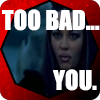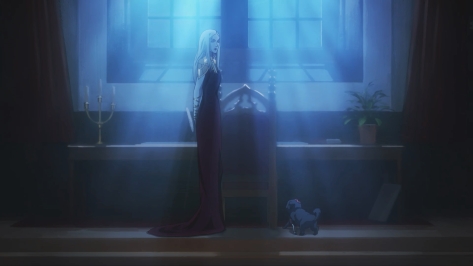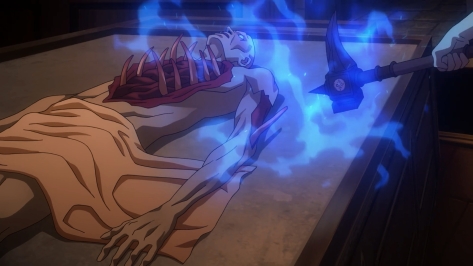Japanese Title: Tate no Yuusha no Nariagari
Similar: Re:Zero
Watched in: Japanese & English
Genre: Action Adventure Drama Fantasy
Length: 25 episodes
Positives:
- Good music
Negatives:
- Loli harem
- Everyone is moronic
- Conflict points forgotten every few episodes
- Infuriating to watch
(Request an anime for review here.)
The Rising of the Shield Hero is infuriating from the very first episode. Should you embark on this isekai journey, know that you will want to pluck your eyes out at the stupidity of the characters before long.
Like all MMO isekai, this story is about an ordinary guy transported into a fantasy world that follows the rules of a video game. The difference here, however, it that he is one of four summoned to save this world from the impending apocalypse against their will. Each hero wields a legendary item – sword, spear, bow, or shield. For some reason, seemingly everyone in this world hates whoever wields the shield. So, of course, Naofumi is bestowed with the power of the Shield Hero.
Matters immediately turn against him when the king ignores him before the court, the one woman who joins his party (fighters flock to the other heroes) robs him like the sucker he is and falsely accuses him of rape. No one believes his denial.
See, this setup sounds good on paper – much of the story sounds good on paper – but the execution doesn’t just fail, it infuriates. Let’s take the trial, where the king and the other heroes determine what to do with the Shield Hero for “raping” the woman. First, everyone believes her without question as if they are dumbest people to have ever lived. No, not as if – they are the dumbest people to have ever lived. Furthermore, Shield Hero can’t even remain consistent. One second he’s accused of rape, which holds an instant death penalty, with the other heroes saying he’s scum and should die, but when he demands to be sent back home, some dipshit says he’s giving up at first sign of trouble? Ah yes, facing death is just “a sign of trouble”. What kind of garbage dialogue is this?
You want to know what happens next? Do they kill him? Do they at least lock him up? Nope, he just walks out.
The purpose of this incident was to strip him of all allies and resources, starting him at the lowest point for maximum conflict in the story. This is good. Executing it in this manner is not. And as I said, Shield Hero can’t keep its story straight. It forgets he’s supposed to be put to death. Yes, word does spread of his “actions” and people shun him at every turn, including merchants ripping him off, but the fact that he supposedly raped a princess (the woman was a princess) may as well have been as serious a crime as pissing on a postman everyone liked.
Let me talk about the whole “the Shield Hero always sucks” device for a moment. We never receive an explanation for why everyone thinks the Shield sucks. The king holds a personal grudge against all Shield Heroes, sure, but why would anyone else go along with it? The peasantry doesn’t give a toss about a king’s feelings.
Then we come to the idea that the Legendary Shield itself is weak. Has this guy not seen 300? It quickly becomes apparent that the Shield has great power, including the ability to summon an iron maiden to crush opponents in a spiked tomb. Furthermore, he’s not the first Shield Hero, which means previous incarnations would have demonstrated its power. Do I need to explain further?
Another weird point is how blasé the four guys are about suddenly teleporting to a fantasy world. The story tries to explain it by saying that three of them played an MMO matching this setting in their alternate versions of Japan (Naofumi read about it in a book). Look, if I ended up in World of Warcraft or Guild Wars one day, it would still be a shock regardless of how many hours days months years I put into those games. It’s as if the isekai genre has become so overdone, so trite that there’s no point trying to sell the premise – the audience will eat it up either way.
Anyway, after the rape trial that everyone forgets, Shield Hero buys himself a slave tanuki-girl called Raphtalia to be his sword since the Legendary Heroes cannot wield other weapons. Raphtalia is probably the best character of the series. After a training curve and going from loli to adult overnight (“game mechanics”), she’s tough, competent, and justifies her presence. I wouldn’t call her great, but it’s a surprise to have a female character of her quality in an isekai harem.
One point of conflict arises when Bitch Princess learns of Raphtalia. She yells about how the Shield Hero is reprehensible for keeping a slave. To nobody’s surprise, everyone sides with her in wanting to lynch him. Doesn’t this kingdom have rampant slavery of demi-humans without checks and don’t all humans, royal family included, treat demi-humans like trash? Why would any of them care he has a slave?
You want to know what happens next? The Spear Hero challenges him to a duel, where the princess cheats for him (everyone sees this, but she says she didn’t cheat, so they believe her [just kill me]), the conflict is explained away by someone finally agreeing that she cheated, and then forgotten like the rape before it.
The presence of these two characters in particular, Spear Hero and princess, tanks the quality of Shield Hero.
A big chicken/loli girl joins Naofumi next in an episode that defies belief. Dipshit Spear Hero and his Bitch Princess are extorting a village with ludicrous taxes that will starve the people. When the Shield Hero objects, they challenge him to a chocobo race for ownership of the village. Naturally, Bitch Princess cheats the whole time. This episode makes Shield Hero feel like the comical Wacky Racers rather than the grim fantasy it so desperately wants to portray. He wins, they bugger off.
Do their actions give them a bad reputation? Take a guess.
It’s like this over and over again. When not on a filler grinding episode (obviously the most interesting part of an MMO…), someone – usually the princess or Spear Hero – accuses him of a crime that warrants death (or equivalent), everyone believes the accuser, he defends himself miserably, the situation resolves because someone says so, and there are no lasting consequences. The only consistency is that everyone hates the Shield Hero. Yet even that only continues by raising idiotic scenario after even more idiotic scenario to have everyone hate him. He saves the world? Doesn’t matter – someone said I should hate him, therefore I do. The way they treat him, even during the apocalyptic waves, you’d think they didn’t want saving.
The stupidest of all conflict points has to be the brainwashing shield. Later in the series, a third loli girl joins Shield Hero’s harem, who turns out to be the other princess and first in line for the throne. Bitch Princess is on her trail to kill the competition. When she catches up to the Shield Hero’s group and sees loli princess with him, what can she do to separate sister from protector? I know! How about accuse him of kidnapping the girl? What? She’s saying she wants to be with him? Hmm, what to do…what to do? That’s right! His shield has a brainwashing power. Does it really? Yes, because I say so. And with that evidence to go on, everyone believes her. (Just tear my eyes out and feed them to the chickens already!)
Execution is wrong at every turn. For instance, the other heroes are more interested in feeding their egos with glory and adoration of the masses. They will sweep into town, solve whatever problem the people are facing, and ride off like champions without consideration for the larger problems created. This is an interesting idea, to have heroes be the cause of problems. Poor execution sadly saps potential. Naofumi rocks up and solves the problem in an episode or two with no lasting effects on the story. Instead of using the “monster of the week” formula, it’s a “problem of the week” structure and just as disposable. Action scenes also follow the “you made me use my trump card” battle structure, which rarely performs well at the best of times. When the trump card does come out, there’s no reason they couldn’t have used it right away to end the fight without injury.
The conflict owes its stupidity to the characters above all. I’ve talked a lot of Bitch Princess (the resolution to her arc is so moronic that you’ll want to blow your brains out to forget it), but she is just the start. Spear Hero, dipshit supreme and useful idiot-in-chief; the other heroes, may as well delete them for how much they bring to the table; loli princess, complains that Shield Hero doesn’t get along with her father, demanding he apologise to the king; the king, why is he king; the populace, none should be saved; and worst of all, Queen Chicken.
Late in the series, the queen of chocobos chickens filolials comes to the Shield Hero and says that if the four heroes don’t learn to work together, they won’t be strong enough to conquer later waves of the apocalypse. She will kill them to summon four new heroes who can do better, should it come to that. Remember how I said that all conflict resolves through hand waving? This threat resolves the hatred from other heroes – never mind the stupidity of not making this clear from the beginning, you absolute. incompetent. imbeciles!
That’s not the worst of it. She says the following to him, in regards to his conflict with other heroes: “Did you every try to get along with them? Did you ever try to defend yourself? If you don’t defend yourself, it will be seen as an admission of guilt.”
Not only was he the friendliest on arrival and not only did he try to defend himself from the very beginning, this logic is utterly moronic. For one, they want him to be guilty. This logic reminds me of those teachers who say to a bullied kid, “Have you tried being nicer [to your bullies]?”
Stupidity just doesn’t stop. Look, just because you make fun of light novel tropes in your first scene, doesn’t make you any better than the rest of them. In fact, you turned out worse! The season ends with consequences for some of the biggest idiots. However, as I said at the start, the execution is wrong every step of the way. The story can’t decide if it’s a grim fantasy, one hero against the world, or some dumb loli harem for idiots. It’s certainly not the former with its inability to kill characters for good.
The Rising of the Shield Hero was the biggest isekai in the first half of 2019. If this is the best the genre has to offer these days, then there is no hope.
Art – Medium
The animation, though inconsistent at times, is good and the world has plenty of texture. Early episodes show promise of high production values, but they drop over time to a decent level.
Sound – Low
I like the OPs with their electro vocals and the acting is good (except the Japanese loli voice, as always), but the writing is another story. It is just so moronic. Every episode brings your head into your hands as you question the mentality of these characters.
Story – Very Low
A guy summoned to a fantasy land unfortunately receives the power of the weakest hero weapon – the shield – and faces endless discrimination as he tries to protect the world that hates him. Good on paper, bad in execution, The Rising of the Shield Hero is a painful train wreck.
Overall Quality – Very Low
Recommendation: Avoid it. The Rising of the Shield Hero is an infuriating experience I don’t recommend to anyone.
(Request reviews here. Find out more about the rating system here.)
Awards: (hover over each award to see descriptions; click award for more recipients)
Positive: None
Negative:



























































